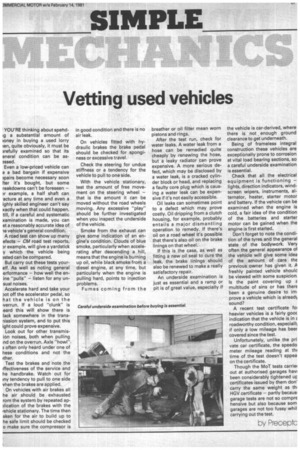Vetting used vehicles
Page 69

If you've noticed an error in this article please click here to report it so we can fix it.
YOU'RE thinking about spendig a substantial amount of toney in buying a used lorry ten, quite obviously, it must be irefully examined so that its eneral condition can be as
Even a low-priced vehicle can e a bad bargain if expensive .1pairs become necessary soon [ter it's bought, but some reakdowns can't be foreseen — )r example, a half shaft can .acture at any time and even a ighly skilled engineer can't say xactly when that could happen. till, if a careful and systematic xamination is made, you can et a reasonably accurate idea of in vehicle's general condition. A road test can show up many efects — CM road test reports, 3r example, will give a yardstick y which the vehicle being ?.sted can be compared.
But carry out these tests you relf. As well as noting general erformance — how well the enme "pulls" — listen for any unsual noises.
Accelerate hard and take your Dot off the accelerator pedal, so hat the vehicle is on the verrun. If a loud "clunk" is eard this will show there is lack somewhere in the translission system, and to put this ight could prove expensive.
Look out for other transmision noises, both when pulling Ind on the overrun. Axle "howl" 3 often only heard under one of hese conditions and not the ither.
Test the brakes and note the !ffectiveness of the service and he handbrake. Watch out for iny tendency to pull to one side vhen the brakes are applied.
On vehicles with air brakes all he air should be exhausted ram the system by repeated ap }lication of the brakes with the fehicle stationary. The time then aken for the air to build up to he safe limit should be checked o make sure the compressor is in good condition and there is no air leak.
On vehicles fitted with hydraulic brakes the brake pedal should be checked for sponginess or excessive travel.
Check the steering for undue stiffness or a tendency for the vehicle to pull to one side.
With the vehicle stationary, test the amount of free movement on the steering wheel — that is the amount it can be moved without the road wheels moving. Any excessive "play" should be further investigated when you inspect the underside of the vehicle.
Smoke from the exhaust can give some indication of an engine's condition. Clouds of blue smoke, particularly when accelerating after descending a hill, means that the engine is burning up oil, while black smoke from a diesel engine, at any time, but particularly when the engine is pulling hard, points to injection problems.
Fumes coming from the breather or oil filter mean worn pistons and rings. After the test run, check for water leaks. A water leak from a hose can be remedied quite cheaply by renewing the hose, but a leaky radiator can prove expensive. A more serious defect, which may be disclosed by a water leak, is a cracked cylinder block or head, and replacing a faulty core plug which is causing a water leak can be expensive if it's not easily accessible.
Oil leaks can sometimes point to a defect which may prove costly. Oil dripping from a clutch housing, for example, probably entails a major dismantling operation to remedy. If there's oil on a road wheel it's possible that there's also oil on the brake linings on that wheel. If this is the case, as well as fitting a new oil seal to cure the leak, the brake linings should also be renewed to make a really satisfactory repair.
An underside examination is just as essential and a ramp or pit is of great value, especially if the vehicle is car-derived, where there is not, enough ground clearance to get underneath.
Being of frameless integral construction these vehicles are exceptionally prone to corrosion at vital load bearing sections, so a careful underside examination is essential.
Check that all the electrical equipment is functioning — lights, direction indicators, windscreen wipers, instruments, alternator, heater, starter motor and battery. If the vehicle can be examined when the engine is cold, a fair idea of the condition of the batteries and starter motor can be gained when the engine is first started.
Don't forget to note the condition of the tyres and the general state of the bodywork. Very often the general appearance of the vehicle will give some idea of the amount of care the previous owner has given it. A freshly painted vehicle should be viewed with some suspicion. Is the paint covering up E multitude of sins or has therE been a genuine desire to im• prove a vehicle which is already sound?
A recent test certificate fol heavier vehicles is a fairly gooc indication that the vehicle is in E. roadworthy condition, especially if only a low mileage has beer covered since the test.
Unfortunately, unlike the pri vete car certificate, the speedo meter mileage reading at thE time of the test doesn't appea on the certificate.
Though the MoT tests carriee out at authorised garages hay, been considerably tightened up certificates issued by them don' carry the same weight as th, HGV certificate — partly becaus, garage tests are not so compre hensive but also because som garages are not too fussy whil carrying out the test.
oy Precept








































































































